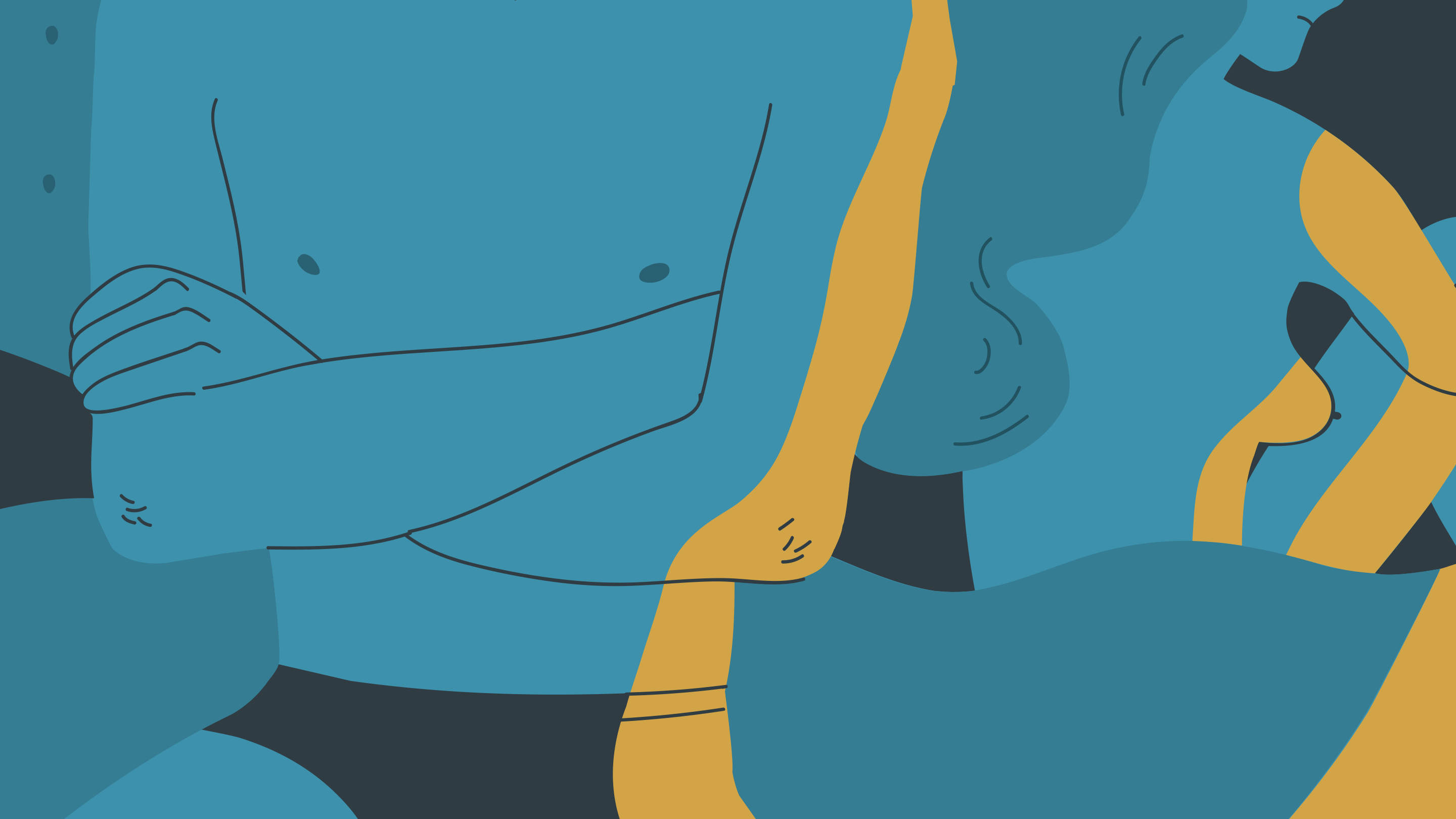
How Do Male Survivors Fit into #MeToo?
Despite CDC numbers stating otherwise, it remains a common belief that women cannot rape men
Tim was having a hard time adjusting. He had just moved to a new city to take a job in a research lab while he prepared to apply to medical school. He had always had a small social circle and now, painfully awkward and suffering from social anxiety and depression, Tim was struggling to make friends. His isolation only grew after he received word that a loved one had died after his move, worsening his already precarious mental health.
He says that’s what made it so hard for him to come forward after she began regularly sexually assaulting him. It started with some flirting around work. Tim, who identifies as asexual, wasn’t interested. “Even if I was straight, I wouldn’t have been attracted to her,” he explains. But there was that pressing loneliness, so despite his discomfort, he kept seeing her socially, week after week. The flirting soon turned to physical acts: first inappropriate touching, then hand jobs. It was consensual, to a point. She held his future career in her hands, and Tim felt that because of his sexual orientation, he “had something to prove” —that the sexual interaction didn’t bother him.
Eventually, the professor escalated further. She would ask to perform oral sex on him and, when he said no, would do it anyway. Sometimes, she didn’t bother with the asking. “She told me that if our, quote unquote relationship, ever ended, she would fire me and sabotage any reference I would try and get from her. That was right when I was applying to med schools, so that was a pretty severe threat. That’s kind of when things started going really south.”
Twice, Tim said he ended up having full sexual intercourse with her. But the most egregious assault came one night roughly eight months after the inappropriate touching first began, when he found himself on her couch, stoned and drunk.
They frame it as this man should consider himself lucky. As a result, if you start asking men about crimes that have been committed against them, they might be less likely to categorize what happened to them as a crime.
In his fear, Tim says he’s not sure if she did penetrate him or not. When he was finally able to move, he left to sleep in the guest bedroom, locking the door behind him. The assault happened during the summer. By winter, he had moved—he would never go to medical school, his interest in the field having waned for other reasons. The move gave him a chance to pursue a new career in computer programming but didn’t fully free him from his rapist. She still messages him. He’s looked into restraining orders, but still hopes that by not answering, she’ll get bored.
The shame also lingers. It’s a story he’s only told his therapist and online support groups. “It’s a huge reason why I haven’t reported it,” he says. “I feel either I wouldn't be believed because people either wouldn’t comprehend or would refuse to accept it. Or I’d be laughed out of a police station or chastised. ‘Are you kidding us? You’re a man telling us a woman made you let her suck your dick?’”
Stories like Tim’s are tragic and heartbreaking, both for the trauma they cause the survivors and because they are so frequently treated like outliers. For years, the idea of a female raping a man was seen as a freak occurrence, something to be explored in a particularly salacious episode of Law & Order: SVU. Recent research, however, suggests that non-consensual, heterosexual sex where the female is the aggressor is far more common than previously thought.
According to a 2010 Centers for Disease Control and Prevention survey, only 1.7 percent of American men said they had been raped in their lifetime, by either a man or a woman. However, 6.7 percent said they had been forced to penetrate someone sexually, and in almost 80 percent of those cases, the person they had been forced by was a woman. In more than half of the cases involving a female perpetrator and male victim, violence was used.
The Fight to Erase the Silencing of Male Victims in America
1in6 is one of the few organizations hoping to help male victims—and no one wants to fund it

That data hasn’t tended to show up in studies that focus on criminal statistics because men have been conditioned to not see what’s been done to them as a crime, says Stemple. “It’s just not the way victims frame it, it’s not the way society frames it,” she says in an interview. “They frame it as this man should consider himself lucky. As a result, if you start asking men about crimes that have been committed against them, they might be less likely to categorize what happened to them as a crime. Whereas in a health context, if you ask them about different things that happened to them over the course of a year… you’ll get people more likely to disclose this experience happened to them.”
The largest impediments to men coming forward aren’t necessarily legal—they’re cultural. In her research, Stemple points to gender stereotypes (men as dominant, women as submissive) that contribute to the idea that not only are men not raped by women, but that they physically can’t be. “The thing I find really resonates with a lot of survivors I’ve worked with over the years is making survivors aware of the fact that it’s very normal for them to experience sexual arousal, even in a non-consensual setting,” she says. “I think for a lot of survivors, they experience arousal. That’s very confusing for them. They think maybe they secretly wanted it, maybe their body betrayed them, maybe part of them enjoyed it.”
It’s a trope hammered home by cheap jokes. Tim remembers telling a much-watered down version of his story to friends, implying he had been not assaulted but sexually harassed. His friend repeated the South Park line from an episode dealing with a female teacher who supposedly had sex with her male students: “Nice.”
Richard Gartner, a clinical psychologist and co-founder of MaleSurvivor: The National Organization Against Male Sexual Victimization, says that in some cases, the stigma for men who admit they’ve been raped by a woman can cut so deep, they will talk themselves into believing they wanted the sex to happen. “They’re more likely to be ashamed if they do recognize it,” he says. “Men believe they’re supposed to have enjoyed it. They’ll talk themselves into it, or they’ll feel very anxious about why they didn’t.”
For a lot of survivors, they experience arousal. That’s very confusing for them. They think maybe they secretly wanted it, maybe their body betrayed them, maybe part of them enjoyed it.
Years before, Nathan had been the victim of molestation at the hands of his grandfather. Those memories came flooding back as she touched him, paralyzing him. She took off his shirt. Somehow, they ended up on her bed, and she began stimulating him. Only one thought went through Nathan’s head: “Oh God, it’s happening again.” The manual stimulation turned into oral sex. Nathan can’t remember if she managed to get him to penetrate her as she mounted him, but everything else is still vivid: the yellow painted walls, the mattress being on a box spring, the television with bunny-ear antennas. It would take him more than a decade to fully acknowledge what had happened.
In the meantime, he suffered spells of regressive disassociation—reverting to a childlike state. Once, in the late ‘90s, he tried to visit a therapist, only to be told they didn’t know what was wrong with him. “I guess I’m too weird to be fixed,” he thought. Subconsciously, the trauma stayed with him, often triggered at things most people would consider innocuous. He remembers seeing the comedy Eurotrip and being horrified at a scene where a backpacker in a Dutch brothel is subjected to numerous over-the-top sex acts against his will.
The average male who was assaulted will take more than 20 years to seek psychological help. Female victims seek help an average of two to three years after being assaulted.
Nathan is a typical case. CDC data shows the average age of a male victim is 12, and according to Andrew Smiler, a clinical psychologist and president of MaleSurvivor, the average male who was assaulted will take more than 20 years to seek psychological help. Female victims seek help an average of two to three years after being assaulted. “If you’re suffering from something for 20 years versus two years, the symptoms can get worse,” he says. “It certainly doesn’t go away. When guys do seek therapy, their symptomatology on average is worse because it’s 20 years down the road instead of two years down the road.”
Like any sexual assault, the trauma can have nasty psychological effects. For men raped by women, Gartner says there can be an added shame—men are not supposed to be raped. Men are supposed to be strong. Admitting to being a sexual assault victim can be like saying you’re less of a man. The pain can manifest in self-destructive ways. Gartner says victims have often turned to drugs, alcohol, gambling, overeating and other destructive behaviors in an effort to cope with the pain.
When We Gender Sexual Assault, Male Survivors Don't Come Forward
Sexual assault is already grossly unreported, but men report sexual crimes far less than women.

It wasn’t just the physical acts that were awful. He says he often found himself playing the role of surrogate husband, taking on the emotional burden of listening to his mother’s grievances about her actual husband—a man who beat Mark.
The family was isolated. Both of Mark’s parents were immigrants, and the household was poor. Mark and his brother tended not to bring friends home from school. As he explains it, there was just a general feeling that outsiders weren’t welcome. There was some extended family around, but they were no help. One of Mark’s brothers was molested by a cousin, and Mark himself was also sexually abused by an uncle. There were obvious signs of neglect. Child Protective Services visited once, though nothing came of it that Mark could see.
As he hit his teenage years, Mark acted out. He cut lots of class and was expelled from school a few times. When he was 15, he started dating a girl four years older than himself. He started smoking pot in his late teens. Then, the drinking began. The memories were largely suppressed until six months ago, when during a yoga session, he suffered a series of flashbacks.
Mark’s awakening to the sexual trauma he experienced came at almost the exact moment that society as a whole was dealing with the same thing writ large. The #MeToo movement has revealed how prevalent sexual assault really is. Women took to social media en masse to share their horror stories and try to finally bring about institutional and societal change. Every survivor interviewed for this article says they’re heartened to see victims being heard. But they feel left out and unsure if now is the time to speak up.
“I do feel it’s very narrow,” says Mark. “It doesn’t cover all that’s going on, it doesn’t encompass male-on-male pedophilia that’s going on in Hollywood, it doesn’t encompass female actors. It doesn’t acknowledge the fact that grown women can rape grown men, too.”
In a 2014 article in the American Journal of Public Health, Stemple critiqued current feminist theories for omitting male victims. Feminists, she argued, should embrace them. By buying into the theory that female perpetrators are rare, we’re reinforcing the gender norms that contribute to the male dominance feminists are fighting against.“Feminism teaches us that women and men vary,” she says. “There are women who are abusers and men who are victims and that is an important feminist lesson.”
While male victims struggle with whether to tell their stories, there has been one movement eager to champion them. Men’s rights activists, an umbrella term for anti-feminist, often virulently misogynistic groups, have taken to inflating statistics regarding female-on-male sexual assaults to push their claims that women are just as violent as men.
For Tim, at least, the ruse is transparent. “Being a male victim, there are the men’s rights activists who on the surface seem to support male victims, but it becomes obvious the more you look into it, they’re not really supportive of you,” he says. “They just like the fact you exist because you’re convenient to be that cover.”
Tim, Nathan and Mark are all in therapy. Tim and Mark both hope to one day form healthy romantic relationships; Nathan is optimistic about reconciling with his wife. But all three are largely silent about what they survived. Tim asked for his name to be changed in this article, and both Nathan and Mark asked that their last names be omitted. 2017 may have been the year women raised their voices, but for males who have suffered at female hands, it’s hard to know when is the time to join the choir.
Over the phone, Nathan demurred when asked what he thinks needs to be done to make it easier for male victims to come forward. Then he brought up an old Friends episode, where a male character helped a friend plan his proposal. One ends up looking like he’s proposing to the other and gay panic laughter ensues. What was funny in the 1990s would be considered homophobic today. He hopes that when it comes to women sexually assaulting men, attitudes will change in the same way.
“There has to be equality here, in both directions,” he says. “It’s not funny. It’s not okay. Just treat everyone equally on this.”
Illustration by GoodStudio






